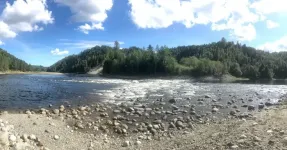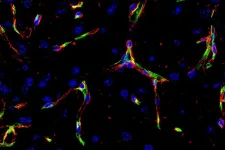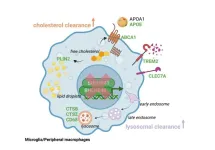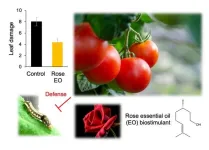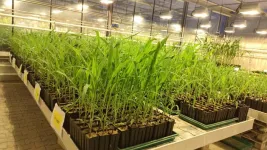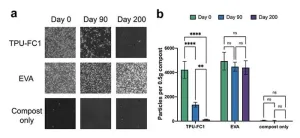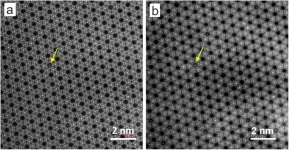(Press-News.org) In a Finnish outcrop nestled between some of Northern Europe's oldest mountains, researchers have found traces of a previously hidden part of Earth's crust that points more than three billion years back in time and north towards Greenland.
These traces were found in the mineral zircon, which after chemical analyses, indicated to researchers from the Department of Geosciences and Natural Resource Management that the "foundation" upon which Denmark and Scandinavia rest, was probably 'born' from Greenland approximately 3.75 billion years ago.
"Our data suggest that the oldest part of Earth's crust beneath Scandinavia originates in Greenland and is about 250 million years older than we previously thought," says Professor Tod Waight, a geologist at the Department of Geosciences and Natural Resource Management.
The researchers’ study of the zircon showed that, in several ways, its chemical fingerprint matches those of some of the oldest rocks on the planet found in West Greenland’s North Atlantic Craton.
"The zircon crystals we found in river sand and rocks from Finland have signatures that point towards them being much older than anything ever found in Scandinavia, while matching the age of Greenlandic rock samples. At the same time, the results of three independent isotope analyses confirm that Scandinavia's bedrock was most likely linked to Greenland," says Department of Geosciences and Natural Resource Management researcher Andreas Petersson.
A water world without oxygen
Denmark, Sweden, Norway and Finland rest atop a part of Earth's crust known as the Fennoscandian Shield, or the Baltic Shield. The researchers believe that it broke away from Greenland as a "seed" and shifted for hundreds of millions of years until it "took root" where Finland is today.
Here, the plate grew as new geological material accumulated around it, until it became Scandinavia. At the time of the crust’s detachment from Greenland, the planet looked very different than today.
"Earth was probably a watery planet, like in the movie Waterworld, but without any oxygen in the atmosphere and without emergent crust. But, because that’s so far back in time, we can’t be really be sure about what it actually looked like," says Tod Waight.
According to the researchers, the fact that Earth even has a continental crust composed of granite is quite special when they look out into space and compare it with other planets in our galactic neighborhood.
"This is unique in our solar system. And, evidence of liquid water and a granite crust are key factors when trying to identify habitable exoplanets and the possibility of life beyond Earth," explains Andreas Petersson.
Continents are the key to life
The new study adds pieces to a primordial continental puzzle that began long before life on Earth truly blossomed, but which has largely paved the way for both human and animal life.
"Understanding how continents formed helps us understand why ours is the only planet in the solar system with life on it. Because without fixed continents and water in between them, we wouldn't be here. Indeed, continents influence both ocean currents and climate, which are crucial for life on Earth," says Andreas Petersson.
Furthermore, the new study contributes to a growing number of studies which reject the means used thus far to calculate how continents have grown – especially during the first billion years of Earth's history.
"The most commonly used models assume that Earth’s continental crust began to form when the planet was formed, about 4.6 billion years ago. Instead, our and several other recent studies suggest that the chemical signatures showing growth of the continental crust can only be identified about a billion years later. This means that we may need to revise much of what we thought about how early continents evolved," says Professor Waight.
At the same time, results of the study add to previous research that found similar "seeds" from ancient crusts in other parts of the world.
"Our study provides us with another important clue in the mystery of how continents formed and spread across Earth – especially in the case of the Fennoscandian Shield. But there is still plenty that we don't know. In Australia, South Africa and India, for example, similar seeds have been found, but we’re unsure of whether they all come from the same "birthplace", or whether they originated independently of one another in several places on Earth. This is something that we would like to investigate more using the method we used in this study," concludes Professor Waight.
About the study
The study demonstrates that the oldest part of Earth's crust beneath Scandinavia comes from Greenland and is about 250 million years older than once thought.
Therefore, Denmark and Scandinavia’s geologic foundation was most likely connected to Greenland approximately 3.75 billion years ago.
The researchers analysed zircons from modern river sand and rock samples from the remote Pudasjärvi and Suomujärvi regions of Finland, whose geological origins have been little studied.
The zircon crystals found in the Finnish river sand originally crystallized in granitic magmas deep within the crust. These granites were then lifted to the surface and eroded to eventually form sand.
The researchers used isotopic compositions of lead, hafnium and oxygen to trace the chemical fingerprint from the Fennoscandian Shield back to Greenland.
The study has been published in the scientific journal Geology.
Contact:
Tod Waight
Professor
Department of Geosciences and Natural Resource Management (Geology section)
University of Copenhagen
todw@ign.ku.dk
Andreas Petersson
Researcher
Department of Geosciences and Natural Resource Management (Geology section)
University of Copenhagen
andreas.zircon@gmail.com
Michael Skov Jensen
Journalist and team coordinator
The Faculty of Science
University of Copenhagen
msj@science.ku.dk
+ 45 93 56 58 97
END
New geological study: Scandinavia was born in Greenland
The oldest Scandinavian bedrock was 'born' in Greenland according to a new geological study from the University of Copenhagen. The study helps us understand the origin of continents and why Earth is the only planet in our solar system with life.
2024-03-21
ELSE PRESS RELEASES FROM THIS DATE:
Research offers hope for preventing post-COVID ‘brain fog’ by targeting brain’s blood vessels
2024-03-21
Among the many confounding symptoms in patients recovering from a COVID-19 infection are memory loss and difficulty learning. Yet little is known about the mechanisms of cognitive impairments like these, commonly called brain fog.
In a new study, researchers at the University of Illinois Chicago have identified a mechanism that causes neurological problems in mice infected with SARS-CoV-2, the virus behind COVID-19. The researchers also found a treatment that helped prevent these changes. Sarah Lutz, assistant professor of anatomy and cell biology in the College of Medicine, led the research, ...
Non-culturable Legionella identified with sequencing
2024-03-21
Highlights:
Legionnaires’ disease is a rare and dangerous respiratory tract infection.
Diagnoses and surveillance usually require culturing isolates.
A new study shows how whole genome sequencing could be used when culturing isn’t an option.
The work points to new avenues for public health surveillance of infectious diseases.
Washington, D.C.—Legionnaires’ disease (LD), a rare and severe type of pneumonia, is a respiratory infection caused by species of Legionella bacteria. One of the most accurate ways to diagnose LD is to perform culture on samples from a patient’s lower respiratory tract, but those samples are difficult ...
Immune cells identified as key players in brain health
2024-03-21
New York, NY [March 21, 2024]—Using novel genetic and genomic tools, researchers at the Icahn School of Medicine at Mount Sinai have shed light on the role of immune cells called macrophages in lipid-rich tissues like the brain, advancing our understanding of Alzheimer’s and other diseases. The study, published in the March 6 online issue of Nature Communications [DOI: 0.1038/s41467-024-46315-7], represents a step forward in understanding immune cell regulation and its impact on disease progression.
The researchers initially studied genes controlling macrophages, also referred ...
Rose essential oil: A safe pesticide for organic agriculture
2024-03-21
Plants-derived essential oils (EOs) find applications in various industries, such as detergents, cosmetics, pharmacology, and food additives. Moreover, EOs have an exceptional safety profile, and their numerous bioactivities greatly benefit human health. Beyond these benefits, EOs have also been found to illicit insect-repellent responses by inducing neurotoxic effects.
Terpenoids are abundant in plant EOs and have garnered widespread attention as they can regulate plant defense responses by regulating the expression of defense genes. For example, soybean and komatsuna plants, when grown near mint, experience a significant improvement in defense properties ...
Researchers identify novel genetic variants associated with Alzheimer’s disease
2024-03-21
Contact:
Jillian McKoy, jpmckoy@bu.edu
Michael Saunders, msaunder@bu.edu
##
Identifying genetic variants and the role they play in predisposing people to Alzheimer’s disease can help researchers better understand how to treat the neurodegenerative condition for which there is currently no cure. A new study led by Boston University School of Public Health (BUSPH) and UTHealth Houston School of Public Health has identified several genetic variants that may influence Alzheimer’s disease risk, putting researchers one step closer to uncovering biological pathways to target for future treatment and prevention.
Published in the journal Alzheimer’s ...
Research team identifies genetic contribution to the composition of the microbiome around maize roots
2024-03-21
In order for plants to grow, they absorb water and nutrients through their roots. In doing so, they rely on tiny helpers: bacteria and fungi in particular are found in a thin layer around the roots. These microbes also ward off organisms that are harmful to the plant, just as the "microbiome" in the human gut helps determine whether we fall ill or stay healthy.
An international research team led by the University of Bonn and with the participation of the IPK Leibniz Institute has now demonstrated on maize plants that the genetic make-up of the host plant has a significant influence on the composition of the root microbes. "It was shown ...
Climate change disrupts vital ecosystems in the Alps
2024-03-21
Reduced snow cover and shifting vegetation patterns in the Alps, both driven by climate change, are having major combined impacts on biodiversity and functioning of ecosystems in the high mountains, according to new research published today.
Mountain ranges covering vast areas of the world are warming much faster than surrounding lowland areas, triggering huge reductions in snow cover and rapid upward movement of dwarf-shrubs, such as heather.
Scientists at The University of Manchester have found that these changes are disrupting the timing of crucial alpine ecosystem functions performed by ...
Say hello to biodegradable microplastics
2024-03-21
Microplastics are tiny, nearly indestructible fragments shed from everyday plastic products. As we learn more about microplastics, the news keeps getting worse. Already well-documented in our oceans and soil, we’re now discovering them in the unlikeliest of places: our arteries, lungs and even placentas. Microplastics can take anywhere from 100 to 1,000 years to break down and, in the meantime, our planet and bodies are becoming more polluted with these materials every day.
Finding viable alternatives to traditional petroleum-based plastics and microplastics has never been more important. New research from scientists ...
New method for analyzing nanoporous materials
2024-03-21
In addition to their main components, the properties of crystalline and nanoporous materials often depend crucially on guest atoms or ions that are embedded in the tiny pores of their lattice structure. This applies to high-tech materials used in sensor or separation technology as well as to natural materials. The bluish gemstone aquamarine, for example, would be colourless without such guest components. Determining the type and position of guest components is difficult, as many materials react sensitively to the radiation emissions ...
An immunotherapy to overcome resistant leukemia
2024-03-21
Acute myeloid leukemia (AML) is an aggressive form of blood cancer. It is caused by mutations in a large number of genes that are acquired in the course of a person’s life. One of these genes – the tumor suppressor gene TP53 – plays a key role. Normally, TP53 helps to prevent the development of tumors. Blood cancer patients in whom this gene is mutated, however, face an extremely poor prognosis, as their genes are resistant to conventional chemotherapeutic agents. Intensive research is therefore being carried out into new therapeutic approaches, ...
LAST 30 PRESS RELEASES:
Injectable breast ‘implant’ offers alternative to traditional surgeries
Neuroscientists devise formulas to measure multilingualism
New prostate cancer trial seeks to reduce toxicity without sacrificing efficacy
Geometry shapes life
A CRISPR screen reveals many previously unrecognized genes required for brain development and a new neurodevelopmental disorder
Hot flush treatment has anti-breast cancer activity, study finds
Securing AI systems against growing cybersecurity threats
Longest observation of an active solar region
Why nail-biting, procrastination and other self-sabotaging behaviors are rooted in survival instincts
Regional variations in mechanical properties of porcine leptomeninges
Artificial empathy in therapy and healthcare: advancements in interpersonal interaction technologies
Why some brains switch gears more efficiently than others
UVA’s Jundong Li wins ICDM’S 2025 Tao Li Award for data mining, machine learning
UVA’s low-power, high-performance computer power player Mircea Stan earns National Academy of Inventors fellowship
Not playing by the rules: USU researcher explores filamentous algae dynamics in rivers
Do our body clocks influence our risk of dementia?
Anthropologists offer new evidence of bipedalism in long-debated fossil discovery
Safer receipt paper from wood
Dosage-sensitive genes suggest no whole-genome duplications in ancestral angiosperm
First ancient human herpesvirus genomes document their deep history with humans
Why Some Bacteria Survive Antibiotics and How to Stop Them - New study reveals that bacteria can survive antibiotic treatment through two fundamentally different “shutdown modes”
UCLA study links scar healing to dangerous placenta condition
CHANGE-seq-BE finds off-target changes in the genome from base editors
The Journal of Nuclear Medicine Ahead-of-Print Tip Sheet: January 2, 2026
Delayed or absent first dose of measles, mumps, and rubella vaccination
Trends in US preterm birth rates by household income and race and ethnicity
Study identifies potential biomarker linked to progression and brain inflammation in multiple sclerosis
Many mothers in Norway do not show up for postnatal check-ups
Researchers want to find out why quick clay is so unstable
Superradiant spins show teamwork at the quantum scale
[Press-News.org] New geological study: Scandinavia was born in GreenlandThe oldest Scandinavian bedrock was 'born' in Greenland according to a new geological study from the University of Copenhagen. The study helps us understand the origin of continents and why Earth is the only planet in our solar system with life.
